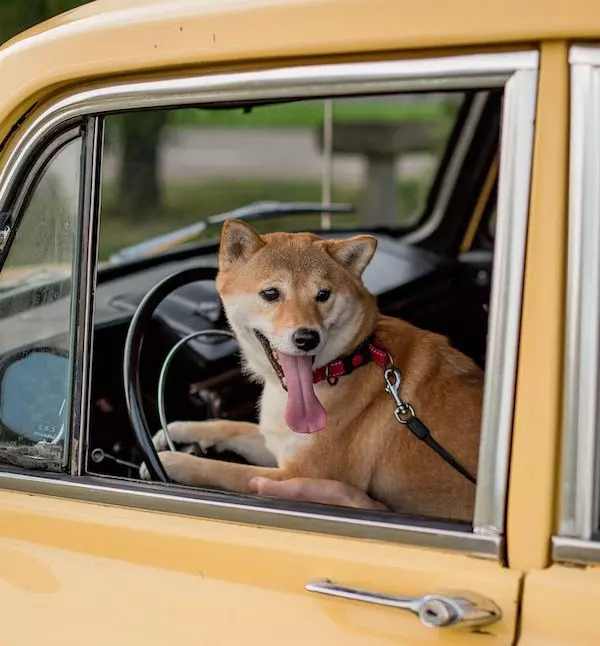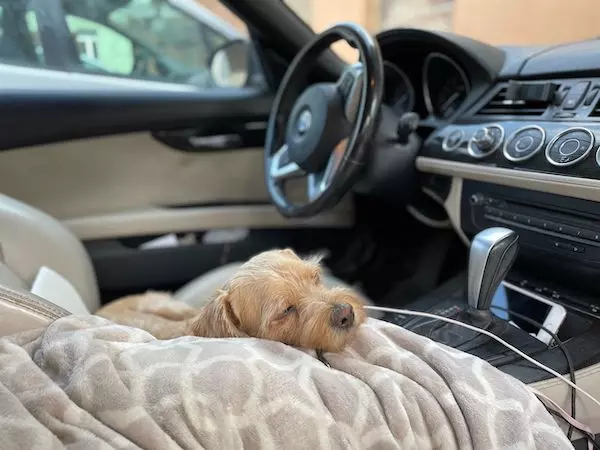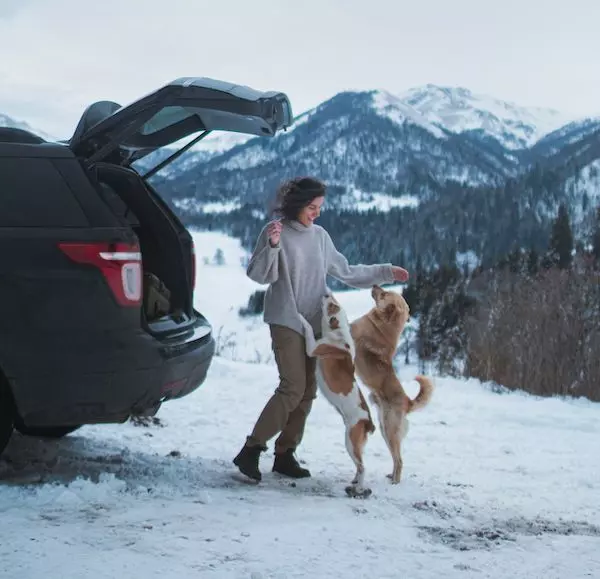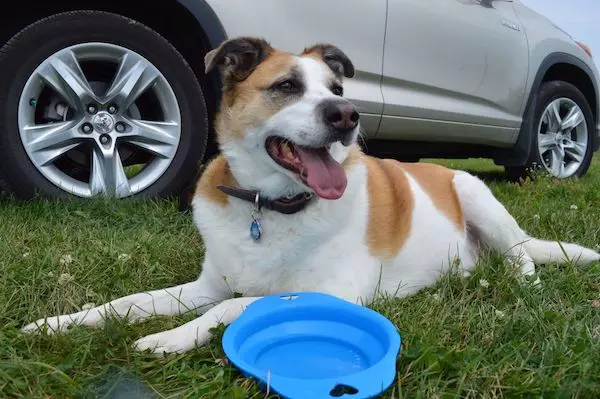
The Ultimate Guide to Traveling with Dogs
July 16, 2022
There's nothing like taking a road trip with your best friend by your side - especially when that best friend is of the four-legged variety! Of course, our furry companions are precious to us, so there are some considerations to bear in mind when planning road trips with dogs.
Whether you're driving cross country with a dog, planning a camping trip with the pup, or enjoying any number of other K-9-friendly adventures on the road, Highway Weather is here to provide you with everything you need to know in order to keep your best bud happy, healthy, and safe along the way! This is the ultimate guide to taking a road trip with dogs.
Checking in with Your Vet
Before hitting the road, it's never a bad idea to speak with your vet. This step in planning a road trip with a dog can be especially important if your dog is a very young puppy or on the older side.
Discussing the nature and extent of the journey with your trusted veterinarian is a great way to gauge whether or not your pooch is up for the trip and whether or not you'll need to take any extra considerations into account.
For example, if your dog is not used to car rides, a long journey all at once may not be the best idea. In this case, it might be better to make a few, shorter trips in order to get them acclimated to the car before embarking on a longer journey.
And in the case of puppies, making sure their vaccinations are up-to-date is important. Not only will this help protect them from any diseases they may come in contact with along the way, but it may also be required if you plan on staying in any hotels or campgrounds.
If your vet gives you the green light for a road trip, the next step is to pack and plan specifically for driving with a dog in the car!
Packing list for traveling with dogs
We'll go over several scenarios in this guide, but we'll start by discussing the basic must-haves for a road trip with a dog. Planning ahead and accounting for these items will make for happy pets and happy people!
Depending on your dog's needs, your vehicle, and other passengers, here are the items you'll want to consider:
A dog harness or seatbelt
Safety, of course, is the priority for everyone in the car! While we humans are required by law to wear our seatbelts, no such regulations ubiquitously exist for our four-legged counterparts. Whether or not the law dictates that you’ll need to restrain your pets in a vehicle, the fact is, a dog harness or dog seatbelt may help keep your pooch safe. We recommend implementing some sort of restraint system, and here’s why:
- It is the law… in a handful of states. In a few states, it is now illegal to drive with an unrestrained pet in the car. Not only is this unsafe for your pet, but it can also result in a hefty fine if you're caught. Does your state require pets to be restrained in the car? Read this overview of US state guidelines for restraining dogs in the car.
- Accidents happen - Even the safest drivers can find themselves in an accident. A dog harness or seatbelt will help keep your pet from being thrown around the car or, worse, out of it entirely if you're involved in a collision.
- Dogs can be a distraction - It's no secret that dogs are cute and lovable, but they can also be a big distraction when you're driving. Having your dog safely secured will help you stay focused on the road.
- Dogs get car sick, too - Just like humans, some dogs experience motion sickness while riding in cars. A harness or seatbelt will help keep your dog from moving around too much and making themselves sick.
Whether you choose a dog harness or a dog seatbelt, make sure that it is comfortable for your pet and that it is properly secured before hitting the road. Your dog's safety is always paramount!
A travel crate or kennel
Perhaps, your dog is on the smaller side. In this case, a travel crate or kennel may be a better option than a harness. Not only will it help keep your pet safe while you're driving, but it will also provide them with a comfortable and familiar space to relax in when you reach your destination. Just make sure the crate or kennel fits your dog well!
When choosing a travel crate or kennel for your dog, be sure to take the following into consideration:
- Size: The crate or kennel should be big enough for your dog to stand up, turn around, and lie down comfortably. Make sure the enclosure isn’t too small! It’s always best to err on the side of more room for your animal.
- Ventilation: Make sure the crate or kennel has good ventilation to keep your pet cool and comfortable.
- Security: Choose a crate or kennel with secure latches to keep your pet safely contained.
- Portability: If you're planning on taking your dog camping or hiking, choose a crate or kennel that is easy to transport.
- Durability: Choose a crate or kennel that is made from sturdy materials that can withstand some wear and tear.
With these factors in mind, you'll be sure to find the perfect travel crate or kennel for your pet!
A bed or blanket for the dog
A dog bed or blanket can help your dog remain comfortable and, not to mention, it'll keep the interior of your car intact if your buddy is prone to shedding! If you're using a travel crate or kennel, consider placing a bed or blanket inside to make it cozier for your pet.

Bowls for food and water and dog food & treats
When considering the best way to travel with a dog, their wellbeing is paramount. You'll need bowls out of which you'll feed and water your dog at appropriate rest stops. Keeping a bag of treats around wouldn't hurt either! Who doesn’t appreciate a road snack?
A word to the wise is to not introduce too many NEW variables to your pet's diet on the road, though. Road trips can be fun and exciting for pooches, but they also tend to make for quite the disruption to your dog's routine.
It's a good idea to stick with the tried-and-true (read: "proven to not upset your dog's tummy") food and treats whilst traveling, as nobody is eager to make a forced rest stop to clean up any messes.
Toys
If you're pondering how to travel with an anxious dog, or perhaps want to provide some entertainment for your pup, it may be a good idea to bring one or two of their favorite toys. A few chew or comfort toys can go a long way in helping your dog feel more at home, less bored, and fully relaxed while on the road.
Don’t forget about what would be fun once you arrive at your destination, though. Did someone say "frisbee" upon arrival to the campsite!?
First Aid kit for dogs
Just like humans, dogs can get injured while traveling. Be prepared for any eventuality by packing a first aid kit specifically for your pet.
First of all, make sure you have your veterinarian's contact information handy. You may need to call them from the road for advice, so you'll want that info easily accessible in the event of any emergencies.
Additionally, you'll want to make sure your pup-friendly first aid kit is nicely stocked. Your dog's first aid kit should include:
- Bandages
- Gauze pads
- Antiseptic wipes or cream
- Cotton balls
- Tweezers
- Scissors
- Hydrogen peroxide (to induce vomiting - only use if directed by a veterinarian!)
- A pet first aid book or card
With a first aid kit on hand, you'll be well prepared for a variety of scenarios.
Poop bags
Nature happens... And, even if you're already IN nature, it's still best practice to always, always pick up after your dog after the "deed" is done.
Poop bags are, therefore, an essential item to have when traveling with a dog. Not only will it help keep your car clean (and smelling fresh!), but it will also show that you're a responsible pet owner.
A good rule of thumb is to pack one poop bag for every couple of hours or so you'll be traveling. This way, you'll be sure to have enough! This is definitely a case where you’d rather over-prepare than under-pack.
Planning Your Route with Dogs in Mind
Now that you have all of the supplies you need, it's time to start planning your route!
Traveling with Dogs in Car Long Distance
If you're driving cross country with a dog, you'll want to make sure to plan plenty of stops along the way.
Dogs need to exercise and relieve themselves frequently, so take this into account when thinking through how often to stop on a road trip with a dog. It's also important to consider the climate when planning your route. If it's going to be hot, make sure to plan for plenty of stops so your dog can stay hydrated and cool.
The Highway Weather app makes it easy for pet owners to understand the weather they'll encounter along their route and strategically plan their stops ahead of time. This helps both people and animals enjoy a safe journey, complete with pet-optimized breaks.

Pet-Friendly Hotels & Campgrounds
When planning your route, you should also look for dog-friendly hotels or campgrounds where you can stay with your pet. This way, you won't have to worry about finding a place to leave your dog while you explore your destination.
Pet-friendly hotels and campgrounds are a surefire way to make certain your dog is comfortable while you're on the road. Many hotel chains offer pet-friendly rooms, so be sure to ask about this when making your reservations.
When it comes to a camping road trip with a dog, you'll want to find a pet-friendly campground. There are a few things to keep in mind. First, you'll want to make sure that the campground allows dogs. Second, you'll want to research the campground to see if there are any restrictions on where your dog can go.
Some campgrounds have designated areas for dogs, while others may require that your dog be on a leash at all times. Be sure to ask about these policies before making your reservation.
Embarking on Your Road Trip with a Dog
Now that your bags are packed, your route is established, and your (and your pup’s) rest stops are planned, it’s time to hit the road! Let’s dive in to making the most our of your and your dog’s trip.
Giving your Dog Exercise on the Road
It's said that dogs have the same mentality as a human toddler. With that in mind, imagine the boredom a toddler may experience during a long road trip! Dogs, not unlike children, need some mental stimulation, too, so your pooch will thank you if you plan some stops with the express intent of stretching your dog's legs.
There are a few ways to give your dog some exercise while on the road. One option is to find a dog-friendly park where your pup can run around and explore. If you're staying at a campground, this may be as easy as taking a short walk to an on-site dog park.

Another option is to find a place to go hiking with your dog. This is a great way to get some exercise for both of you! Just be sure to research the trail before you go to make sure it's appropriate for your dog.
The last option is to simply stop at a rest area and let your dog run around. This is usually not the best option, as rest areas can be noisy and crowded. However, if you're in a pinch, it's better than nothing! Just be careful of others. A leash might come in handy here.
Letting your Dog Relieve Themselves
Ideally, the most efficient way to carry out "nature breaks" is to have your dog do their business at the same time they get to stretch their legs or play. However, if your route doesn't account for a walk, hike, or fetch session, finding a safe place for your dog to potty is essential.
The best option is to find a grassy area away from the road. This will give your dog a chance to relieve themselves without being in danger of cars or other hazards. If you can't find a grassy area, sand or dirt are also good options. Just be sure to clean up after your dog!
Another option is to stop at a rest area that has a designated area for dogs. This is usually fenced in and away from the main areas of the rest area, so it's a safe place for your dog to do their business.
If you're in a pinch, you can also use a potty bag. These are bags that are designed to collect your dog's waste. They're easy to use and can be disposed of properly when you find a trash can.
Feeding / Watering your Dog on the Road
It seems like obvious guidance, but we all know how the hours can turn into minutes on a long road trip. The hours and miles fly by in no time, and it can be easy to lose track of your pooch's feed and watering schedule.
Making sure your dog is properly hydrated is incredibly important, so if you're used to your dog being able to simply drink when they're thirsty at home, you may want to set a timer on your phone to remind you of key hydration breaks you'll want to give your pup.

The same importance should be placed on food as well. While you don't want to OVER-feed your dog, you'll want to make sure they have enough to eat. If they typically follow a feeding schedule, it'd be best to try to generally adhere to that on the road.
Don't forget, a great way to ensure that your dog is getting proper nutrition on the road is to bring along their normal food and treats. This way, you can be sure they're getting what they need and you don't have to worry about them not liking the food at your destination.
Reducing your Dog's Anxiety on the Road
Sometimes, a road trip might be a bit rough on your pup's nerves. More often than not, they'll make it pretty apparent they're unhappy by whining, excessively panting, and acting restless.
There are a few things you can do to help reduce your dog's anxiety on the road.
First, try to keep to their normal routine as much as possible. If they normally go for a walk in the morning, make sure to do that before you hit the road. If they typically eat at 6pm, try to stick to that schedule.
Second, don't forget about the packing list we mentioned above! Make sure they have a comfortable place to sleep, their favorite toys, and some nice treats.
Pro tip: If your dog has a favorite bet they sleep on at home, bring the same bed along or find a way to replicate it in the car. This will help them feel more comfortable and safe.
For more tips and tricks on how to reduce anxiety in your four-legged-buddy, the Central California SPCA has seven great ideas for you.
Phew! That's a lot of info on traveling with a dog. But we hope that, armed with this knowledge, you feel confident and excited to hit the open road with your furry friend by your side!
Do you have other ideas about traveling with dogs? Connect with us on Facebook, Instagram, or Twitter, and share them!






